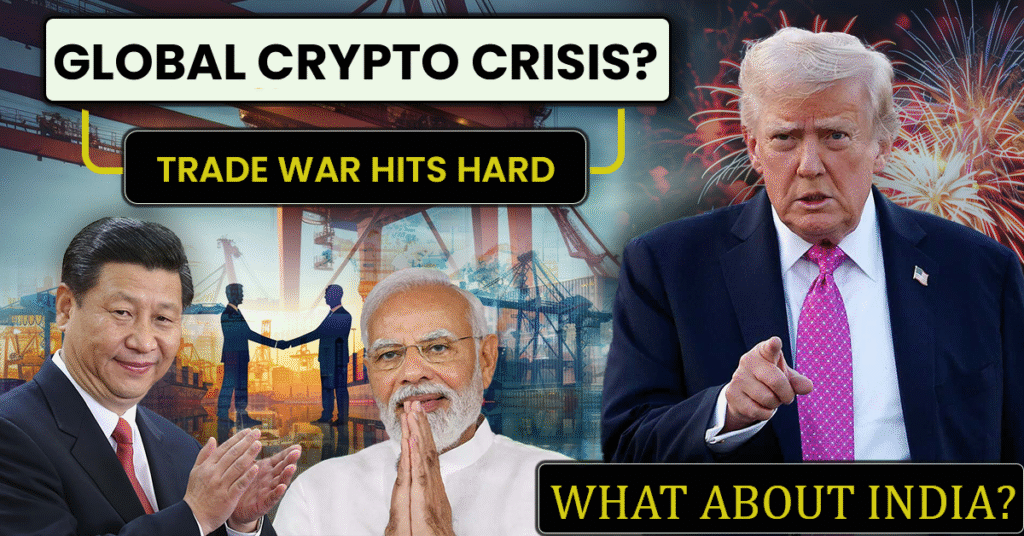
The tensions between the United States and China, which have long been simmering, have once again boiled over into a full-scale trade war. In a startling policy statement, former U.S. President Donald Trump announced a 100% tariff on Chinese products and new export limitations on high-tech products, especially chips, artificial intelligence parts and digital infrastructure equipment. This step, which will be implemented since November 1 or previously, has already caused shock in the world markets, both in manufacturing and equities and, to a growing extent, in cryptocurrencies.
What Happened and Why It Matters
- The American government declared an extensive plan of action to cut the reliance on Chinese production and control the access of American technologies to Beijing.
- The 100 per cent tariff amounts to doubling present levies on numerous Chinese exports, including semiconductors and electric vehicles, as well as solar parts.
- Another action by Washington was the export limitations in essential technologies, limiting U.S. companies.
Why This Trade War Is Different
This is not a struggle concerning physical goods or predominance in manufacturing, as the previous tariff rounds of 2018-2019 did. It concerns the digital power that the future economic architecture.
National strategies are now based on artificial intelligence, semiconductors, and blockchain technology. According to the U.S., technology exports are its tool to delay the technological rise of China, and state-run programs such as the digital yuan of China seek to go around the dollar-based systems.
In such a case, cryptocurrencies and decentralised finance will be unwitting participants in the game of geopolitical chess. With the trust in centralised systems going good and bad, digital assets provide investors, or even countries, with a second path to store or transfer value that is not part of conventional channels managed by the U.S. or China.
The U.S. Position: Regulation with Strategy
Washington still polishes its domestic crypto policy, despite imposing tariffs. The new trend of regulatory clarity, i.e. defining stablecoins, capital requirements, and tightening of AML norms, is not a coincidence.
Institutionalisation of crypto by the U.S. financial law would guarantee that American capital flows are controlled by the U.S., even in decentralised systems, and enhance its control over them. Such regulatory clarity is also a capital magnet as venture firms and institutional investors are likely to base their digital activities in the U.S.
India’s Dilemma Between Opportunity and Oversight
India is in a very fragile position. With the world supply chains re-balancing and businesses aiming to break their reliance on China, India might also be a good alternative whenever it comes to technology production and digital finance design.
The hard crypto policy of the country, though, with 30 per cent on the profit and 1 per cent on transactions as taxes, still sends investors and startups out of the country. The central bank of India supports its digital rupee (CBDC), but the rest of the crypto sector is regulated by uncertainty.
The second wave of trade war might provide strategic opportunities:
- Change of Supply Chains: There are additional technologies companies that might move manufacturing and research and development centres to India, which will have a spillover impact on the adoption of fintech and blockchain.
- Dollar-Yuan Polarisation: The growing financial disconnection between the U.S and China may make India and its digital payments system, such as the e-rupee, a transactional neutral in South Asia.
- Investor Diversification: Digital and fintech investments will be hedged in emerging markets such as India, as global investors fear the possibility of exposure to China.
However, the restrictive crypto policies in India could prevent its full utilisation of this change.
The Crypto Market’s Immediate Reaction
Bitcoin and Ethereum were volatile in the hours after the announcement of the tariffs. Bitcoin first surged by almost 4% due to the fear of macro instability among investors. However, when the liquidity became tight and the U.S. equity markets declined, crypto prices came down.
The trend highlights the way digital assets are shifting to be treated as a risk asset and a hedge asset – in the opposite direction to trust in traditional markets, yet susceptible to liquidity shocks.
The ripple effects are already felt by Indian investors. Rupee decreased marginally against the dollar, with the volumes on the domestic crypto exchanges falling amidst uncertainty. Nevertheless, the activity of stablecoins increased in the global exchanges, especially that of USDT and USDC, as traders rushed to seek immediate protection against volatile conditions.
Broader Implications for Global Finance
The emerging trade embargo makes the boundary between economic policy and technological warfare unclear. The U.S. is effectively weaponising technology by cutting China off from high-tech chips and digital gadgets, which might disintegrate international financial systems.
The growth of the conflict may also lead to a situation where countries resort more to the usage of digital assets and decentralised networks in order to circumvent geopolitical boundaries. Bitcoin-based payment systems may become a level of neutrality, where international trade is possible without using standard agents.
To India, this fragmentation is both challenging and an opportunity. On the one hand, capital flight and market volatility may be caused by the instability of the world. Contrarily, it also provides India with an opportunity to establish itself as a digital non-aligned power – to strike a balance between relations with the U.S. and independent fintech and crypto infrastructure.
Will there be a digital cold war in future?
The new digital aspect of the trade war may introduce a new starting point for the financial realignment. As the world grows closer together due to tariffs, export bans and digital currency strategies, it is entering a period where technology, money and geopolitics cannot be separated.
Cryptomarkets, as shaky as they are, are likely to become the first sign of this change, as they can more quickly reflect the world and its confidence, risk-taking, and capital flow trends than any index.
In the case of India, it is the challenge of balancing regulation and preparedness. The capacity of India to develop an independent but creative digital policy may spell out its position in the next major economic battle of the world, the digital dominance race, as the U.S. and China draw new battle lines.
A digital marketer possessing excellent knowledge and skill in off-page, on page and local SEO is competent in the challenging environment. Hard-working, energetic, and a quick learner for any task delegated. Enthusiastic to learn and constantly upgrade knowledge. Mohit brings over 2 years of experience in crafting content that not only ranks well but also provides valuable insights to readers.

